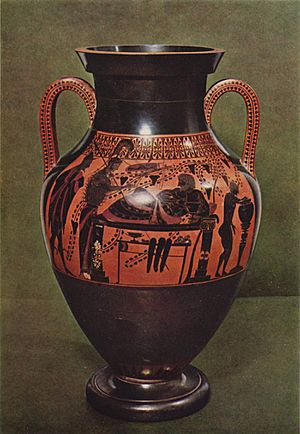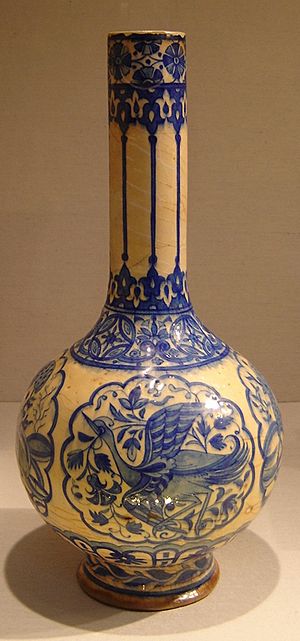Glaze facts for kids
Glaze is a special shiny layer or coating used on things made of pottery or ceramics. You might also hear it called vitreous enamel or porcelain enamel.
Imagine tiny bits of glass powder. This powder is put onto a ceramic item and then heated in a very hot oven called a kiln. The temperature is usually between 750 and 850 degrees Celsius (about 1,380 to 1,560 degrees Fahrenheit). When it gets that hot, the powder melts and flows smoothly over the item. Then, as it cools, it hardens into a strong, smooth, and often shiny coating. This coating can be put on metal, glass, or ceramics.
Why Do We Use Glaze?
Glaze has many important jobs! Sometimes it's used just for decoration, to make pottery look pretty with different colours and designs. But it also has a very practical use: it makes pottery waterproof. Without glaze, many earthenware pots would leak water.
Glaze is used on different types of pottery, like earthenware, stoneware, and porcelain. Besides making things waterproof, glazes can create different looks. They can be super shiny (glossy) or dull (matte). They can also add colour or make a design on the pottery stand out more.

How Glaze is Made
Making glaze involves mixing several ingredients. The main ingredient is usually silica. This is what forms the glass when the glaze is heated.
Other important ingredients are:
- Fluxes: These are metal oxides like sodium, potassium, and calcium. They act like helpers, lowering the temperature needed for the glass powder to melt.
- Stiffeners: Alumina, often found in clay, helps the melted glaze stay in place. It stops the liquid glaze from running off the pottery before it hardens.
- Colours: Different metal oxides create different colours. For example, iron oxide can make reds or browns, copper carbonate can make greens or blues, and cobalt carbonate often makes deep blues.
- Opaquifiers: Materials like Tin oxide or zirconium oxide are added to make the glaze opaque. This means you can't see through it, giving the pottery a solid, non-transparent colour.
Glaze in History
Glaze has been used for thousands of years! It's not just for small pots and dishes. It has also been used on building materials. A famous example is the Iron Pagoda in Kaifeng, China. This tall tower was built in 1049 and is made of special glazed bricks. The glaze helped protect the bricks and gave the pagoda its unique look.



